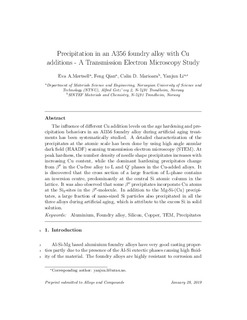| dc.contributor.author | Mørtsell, Eva Anne | |
| dc.contributor.author | Qian, Feng | |
| dc.contributor.author | Marioara, Calin Daniel | |
| dc.contributor.author | Li, Yanjun | |
| dc.date.accessioned | 2020-02-04T08:57:46Z | |
| dc.date.available | 2020-02-04T08:57:46Z | |
| dc.date.created | 2019-05-04T11:34:55Z | |
| dc.date.issued | 2019 | |
| dc.identifier.citation | Journal of Alloys and Compounds. 2019, 785 1106-1114. | nb_NO |
| dc.identifier.issn | 0925-8388 | |
| dc.identifier.uri | http://hdl.handle.net/11250/2639463 | |
| dc.description.abstract | The influence of different Cu addition levels on the age hardening and precipitation behaviors in an Al356 foundry alloy during artificial aging treatment has been systematically studied. A detailed characterization of the precipitates at the atomic scale has been done by using high angle annular dark field (HAADF) scanning transmission electron microscopy (STEM). At peak hardness, the number density of needle shaped precipitates increases with increasing Cu content, while the dominant hardening precipitates change from in the Cu-free alloy to L and Q′ phases in the Cu-added alloys. It is discovered that the cross section of a large fraction of L-phase contains an inversion center, predominantly at the central Si atomic column in the lattice. It was also observed that some precipitates incorporate Cu atoms at the Si3-sites in the -molecule. In addition to the Mg-Si-(Cu) precipitates, a large fraction of nano-sized Si particles also precipitated in all the three alloys during artificial aging, which is attributed to the excess Si in solid solution. | nb_NO |
| dc.language.iso | eng | nb_NO |
| dc.publisher | Elsevier | nb_NO |
| dc.rights | Attribution-NonCommercial-NoDerivatives 4.0 Internasjonal | * |
| dc.rights.uri | http://creativecommons.org/licenses/by-nc-nd/4.0/deed.no | * |
| dc.title | Precipitation in an A356 foundry alloy with Cu additions - A transmission electron microscopy study | nb_NO |
| dc.type | Journal article | nb_NO |
| dc.type | Peer reviewed | nb_NO |
| dc.description.version | acceptedVersion | nb_NO |
| dc.source.pagenumber | 1106-1114 | nb_NO |
| dc.source.volume | 785 | nb_NO |
| dc.source.journal | Journal of Alloys and Compounds | nb_NO |
| dc.identifier.doi | 10.1016/j.jallcom.2019.01.229 | |
| dc.identifier.cristin | 1695581 | |
| dc.relation.project | Norges forskningsråd: 197405 | nb_NO |
| dc.description.localcode | © 2019. This is the authors’ accepted and refereed manuscript to the article. Locked until 23 January 2021 due to copyright restrictions. This manuscript version is made available under the CC-BY-NC-ND 4.0 license http://creativecommons.org/licenses/by-nc-nd/4.0/ | nb_NO |
| cristin.unitcode | 194,66,35,0 | |
| cristin.unitname | Institutt for materialteknologi | |
| cristin.ispublished | true | |
| cristin.fulltext | postprint | |
| cristin.qualitycode | 1 | |

